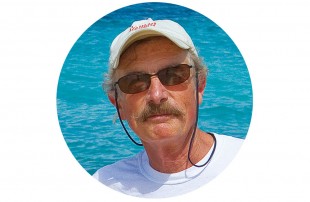Better sail smart and fast, your fans are watching

The butchers at Bernie’s Fine Meats are yacht racing fans.
Bernie’s is an institution behind a downtown storefront dating to the early-20th century in the small city that is SAILING’s home port. The current owner and his employees don’t know a jib from a jibe, but they avidly follow the racing exploits of local sailors. When the owner of a boat that had finished first in a recent long-distance race walked into the meat market to pick up an order of steaks, she was greeted with cheers and high-fives. The Bernie’s crew had been watching the race, though it took place many miles offshore.
I wish I could reclaim some of the hours wasted as a member of sailing trade groups trying to cook up strategies to get the non-sailing public interested in our sport. None of the ideas that came forth were worth the marker ink it took to list them on the whiteboard that was mandatory for the brainstorming sessions of the time. No one suggested: Let’s invent an app that lets people watch sailboat races on their smart phones.
That app was eventually invented, of course. It’s called YB Races, and it has introduced uncountable numbers of people worldwide to sailboat racing. It’s made sailing a spectator sport for non-sailors, while entertaining the knowledgeable sailors in its audience and giving racers a new tactical tool. Not to mention that it’s endorsed by the faithful YB users at Bernie’s butcher shop.
YB involves the expected complex tech, but it springs from a simple idea. Boats in a race carry a tracking device that automatically transmits their position, speed and heading via the Iridium satellite network. The information is delivered to app users as a graphic display along with numeric data particular to each boat.
The system developed by the British company YB Tracking (formerly known as Yellow Brick) can track positions anywhere in the world, so it’s also used for land-based competitions on foot and in vehicles. Sometimes land and water tracking overlap, as when a sailor forgets to turn in the tracker at the end of a race and drives away with it in his car. YB viewers suddenly see a boat sailing at amazing speed over land.
The genius of the system is that the display of the boats and their tracks on a map of the race course is interactive. Touch on a boat shape and its name appears. Tap the information symbol and the boat’s speed and heading come up, along with its standing in the fleet based on its handicap. YB viewers sometimes know who the race winners are before the sailors themselves.
This is not a video game and it’s not a real-time look at a race—positions are updated at intervals as short as five minutes—but it seems to be addictive. People tell me that during a day at work, an evening at home and sometimes even in the middle of the night they can’t resist checking repeatedly to see how the boats they’re pulling for are doing.
For the sailors in a race, YB is more than entertainment. It provides needed information about the competition. Every boat within cell phone range can access it, and it’s available anywhere on the race course to boats with satellite data receivers. It can even be integrated into routing software like Expedition.
Finding out where other boats in your section are can be either exhilarating or depressing depending how far ahead or behind you they are, but the speed and heading data are always useful. When YB shows a competing boat sailing the wrong way at 2 knots, it’s a warning to stay away from a weak-winded part of the ocean or lake.
For sailors in the Chicago-Mackinac race, tracking was a technological leap rivaling the wonder of email replacing snail mail. Before it arrived, competitors were required to report their positions by VHF radio to race authorities on a Coast Guard vessel following the racers. The positions were crude at best, being merely the boats’ locations in one of the grids printed on a map, but at least the process was amusing.
The position reports were public information within VHF range, and crews listened with anticipation. Some of the reported positions were suspect enough to produce guffaws, either ridiculously far up the course, perhaps to demoralize opponents, or far back in an attempt to sneak up on the unwary.
Transponders don’t provide similar amusement because they don’t lie. But I have to say, they are not an unmixed blessing. Before they were in vogue, sailboat races played out in virtual obscurity. No one was watching, and gaffes, miscues and plain dumb decisions went largely undetected. With YB, they are recorded, and the experienced sailors in the audience can be tough critics. Returning racers can encounter some pithy commentary.
“What don’t you get about covering your competition?”
“What were you thinking when you took that ridiculous flyer?
“You sailed outside of Beaver Island! Are you nuts?”
The fans at Bernie’s would be more understanding. After seeing a disappointing performance by a customer on YB, they would probably just change the subject from the quality of your sailing ability to the quality of their steaks.

Comments